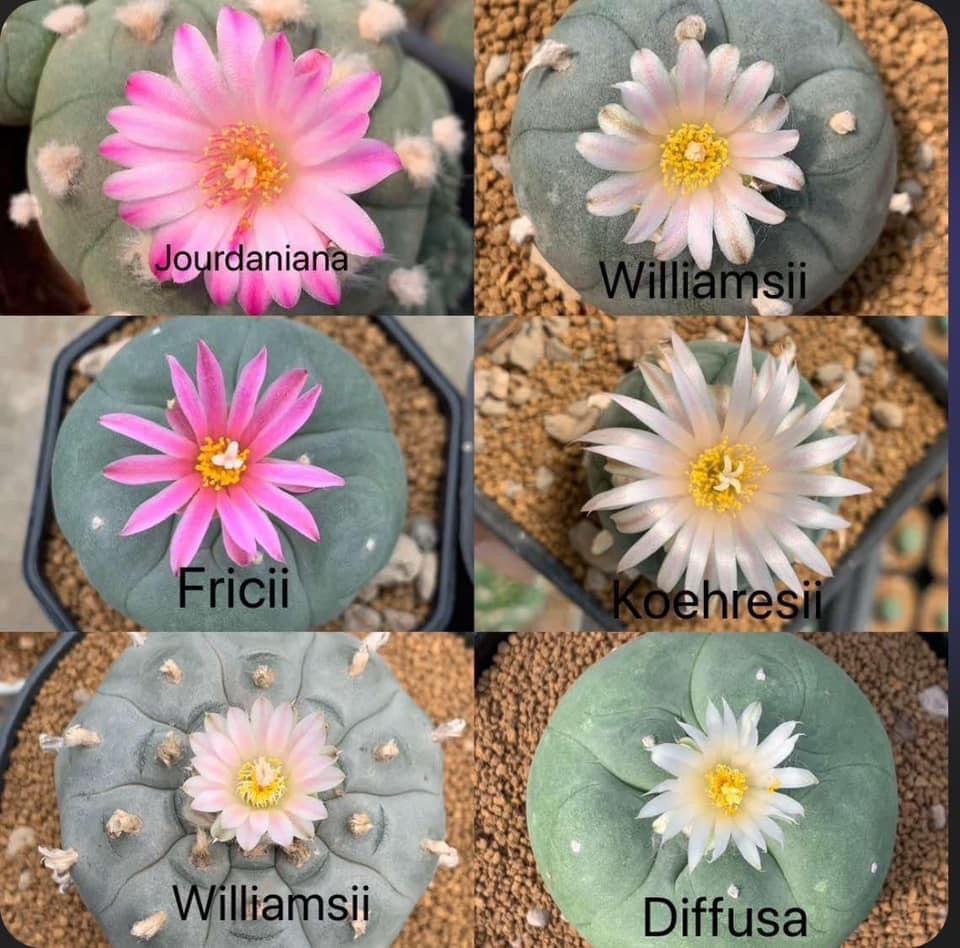
Exploring the Fascinating World of Lophophora: Origins and Varieties
Share

If you’re a cactus enthusiast or a curious plant lover browsing our store, you’ve likely encountered the mesmerizing genus Lophophora. Known for their small, spineless bodies and vibrant flowers, these peyote cacti are as intriguing as they are beautiful. Native to arid regions of Mexico and the southwestern United States, each type of Lophophora boasts a unique origin story and habitat. In this article, we’ll dive into the origins of Lophophora fricii, Lophophora koehresii, Lophophora diffusa, Lophophora jourdaniana, Lophophora caespitosa, Lophophora williamsii var. huizache, and Lophophora williamsii var. texana. Whether you’re adding these to your collection or simply admiring their resilience, here’s everything you need to know about where they come from.
Lophophora Fricii: The Coahuila Gem
Lophophora fricii hails from a tiny corner of northern Mexico, specifically around the lagoon near Viesca in Coahuila. This rare species thrives in two distinct habitats: flat plains dotted with xerophyllous scrub, mesquite, and agave, and rugged limestone slopes or mountain tops. Its limited range makes it a standout in the Lophophora family, perfectly adapted to the harsh desert conditions of the Chihuahuan Desert. If you’re looking for a cactus with a strong sense of place, L. fricii embodies the wild spirit of Coahuila.
Lophophora Koehresii: The Desert Flat Dweller
Next up is Lophophora koehresii, a species rooted in the arid landscapes of San Luis Potosí and Zacatecas, Mexico. Found at elevations of 1,500 to 2,000 meters, this cactus prefers the sandy or rocky soils of alluvial silt flats, where it endures dry spells and occasional floods. Unlike its rock-loving relatives, L. koehresii stands out for its mud-flat habitat, showcasing the diversity within the genus. Its ability to thrive in such extreme conditions makes it a testament to nature’s adaptability—and a stunning addition to any collection.
Lophophora Diffusa: Querétaro’s Desert Star
Traveling south to Querétaro, we find Lophophora diffusa, a species more restricted in its range than others in the genus. Nestled in the Chihuahuan Desert at 1,300 to 1,800 meters, it grows in flat or gently sloping areas with calcareous soils and xerophytic scrub. Unlike the more widespread L. williamsii, L. diffusa is a localized treasure, its soft, pale green body blending seamlessly into its dry surroundings. For collectors seeking something unique, this Querétaro native offers a subtle charm.
Lophophora Jourdaniana: The Mystery of Cultivation
Lophophora jourdaniana presents a different kind of story—one without a clear wild origin. Widely believed to be a cultivated variant or hybrid, possibly derived from L. williamsii, it has never been found growing naturally. Its rose-violet flowers and spiny young areoles set it apart, traits that likely emerged through selective breeding in horticulture. Some trace its roots to German nurseries importing Mexican Lophophora decades ago, but genetic studies suggest it’s closely tied to L. williamsii. For growers, L. jourdaniana is a captivating enigma, a product of human ingenuity rather than a specific desert locale.
Lophophora Caespitosa: The Clumping Wonder
Often listed as Lophophora caespitosa, this isn’t a distinct species but a growth form of L. williamsii known for its clustering habit. Native to northern Mexico (Coahuila, Nuevo León, San Luis Potosí, Zacatecas, Tamaulipas, and Chihuahua) and southern Texas (especially around Laredo), it flourishes in the Chihuahuan Desert and Rio Grande Valley. At elevations from 100 to 1,500 meters, these cacti form dense clumps in rocky, limestone soils or alluvial flats. The caespitosa form’s tendency to multiply makes it a favorite for those who love a fuller, more dynamic display.
Lophophora Williamsii var. Huizache: The San Luis Potosí Spiral
Next, we have Lophophora williamsii var. huizache, a variant named after the Huizache region in San Luis Potosí, Mexico. Growing at 1,400 to 1,500 meters in gravelly, limestone-rich soils among scrub vegetation, this form is part of the broader L. williamsii range that spans multiple Mexican states and southern Texas. Known for its spiral rib patterns and variability, it’s a southern expression of peyote, distinct from its northern cousins in root and flower traits. For those drawn to regional diversity, huizache offers a taste of San Luis Potosí’s desert heritage.
Lophophora Williamsii var. Texana: The Lone Star Native
Rounding out our list is Lophophora williamsii var. texana, a variety celebrated for its stronghold in southern Texas, USA. While L. williamsii spans a wide range across northern Mexico and into Texas, the texana variant is particularly tied to the Rio Grande Valley and Trans-Pecos regions, including areas like Starr, Zapata, and Jim Hogg counties. Found at lower elevations (50 to 300 meters), it thrives in sandy or gravelly soils amid thorn scrub and desert grasslands. Often forming larger, more robust plants than its Mexican counterparts, texana is a proud representative of the Lone Star State’s rugged beauty, blending seamlessly into the broader L. williamsii population.
Why Lophophora Matters
From the rugged slopes of Coahuila to the flats of Texas, each Lophophora type tells a story of survival and adaptation. Whether they’re wild natives like L. fricii and L. texana or cultivated curiosities like L. jourdaniana, these cacti captivate with their resilience and beauty. At our Sacred Cacti store, we celebrate this diversity, offering you a chance to bring a piece of the desert into your home. Which Lophophora will you choose to grow next? Explore our collection and connect with these incredible plants today!
